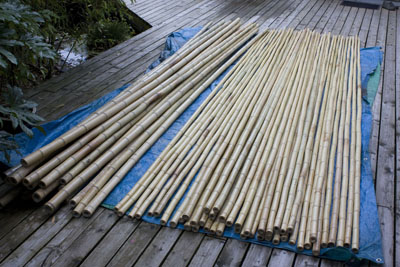Estimating and selecting the bamboo poles was a non-trivial task, despite the seeming simplicity of the fence.
 First, younger (and thinner) bamboo poles tend to have more taper than older (and thicker) poles. The aesthetics of the fence demanded poles which were as straight as possible with the minimum of variation in diameter, especially for the horizontal dōbuchi, which would be approximately 1.8 metres in length. The much shorter vertical tateko would not be as much of an issue, but it would be highly optimistic to expect to get 3 perfect 1 metre tateko out of a 3 metre pole, assuming the usual end splits and bends. And each tateko must have its narrower (suekuchi) end at the top and be cut just above a joint (fushidome) to prevent water getting inside the cane.
First, younger (and thinner) bamboo poles tend to have more taper than older (and thicker) poles. The aesthetics of the fence demanded poles which were as straight as possible with the minimum of variation in diameter, especially for the horizontal dōbuchi, which would be approximately 1.8 metres in length. The much shorter vertical tateko would not be as much of an issue, but it would be highly optimistic to expect to get 3 perfect 1 metre tateko out of a 3 metre pole, assuming the usual end splits and bends. And each tateko must have its narrower (suekuchi) end at the top and be cut just above a joint (fushidome) to prevent water getting inside the cane.
In the end, I decided to order 4 metre lengths of 40/45mm diameter bamboo for the dōbuchi, on the basis that I should be able to get 2 poles of 1.8 metres with reasonably consistent diameter out of each. And I ordered 4 metre lengths of 30/35mm for the tateko, in the expectation of getting an average of 3 poles out of each.
From previous experience, I also decided to keep the poles as dry as possible before use and to rub each cut piece with boiled linseed oil before fitting to the fence. However, this does not seem to have had any beneficial effect in minimising discolouration.
next